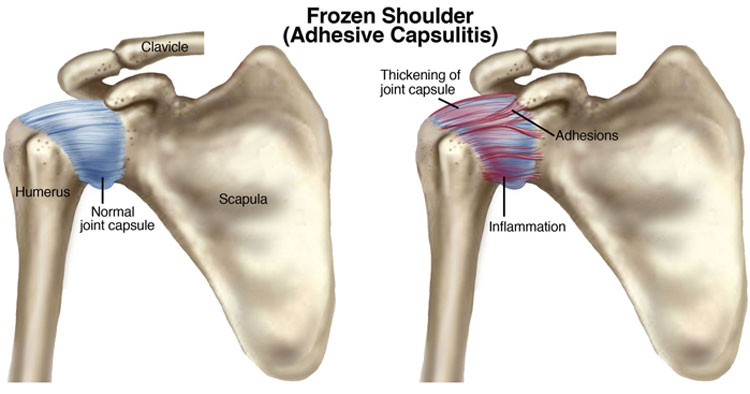Frozen Shoulder: Symptoms, Causes, Treatment
What are the symptoms of frozen shoulder?
Frozen shoulder, also known as adhesive capsulitis, is a condition characterized by stiffness and pain in the shoulder joint. The symptoms typically develop gradually and can vary in severity. Common symptoms of frozen shoulder include:
- Pain: Persistent pain in the shoulder that may worsen at night or with movement.
- Stiffness: Gradual loss of shoulder mobility, making it difficult to perform daily activities such as reaching overhead or behind the back.
- Limited range of motion: Difficulty moving the shoulder joint, especially in certain directions.
- Painful movements: Pain or discomfort when moving the shoulder, especially during activities that involve raising the arm or rotating the shoulder.
- Muscle weakness: Weakness in the shoulder muscles due to lack of use.
- Progressive symptoms: Symptoms may worsen over time and can last for several months to years if left untreated.
If you are experiencing symptoms of frozen shoulder, it’s important to see a healthcare provider for a proper diagnosis and treatment plan.
What are the causes of frozen shoulder?
The exact cause of frozen shoulder is not fully understood, but several factors may contribute to its development. These factors can include:
- Immobilization: Immobilization of the shoulder joint, such as after surgery, injury, or prolonged periods of inactivity, can lead to the development of frozen shoulder.
- Inflammation: Inflammation of the shoulder joint, often as a result of conditions such as tendinitis, bursitis, or rotator cuff injury, can contribute to the development of frozen shoulder.
- Other medical conditions: Certain medical conditions, such as diabetes, thyroid disorders, heart disease, or Parkinson’s disease, have been associated with an increased risk of developing frozen shoulder.
- Age and gender: Frozen shoulder is more common in people over the age of 40 and is more common in women than in men.
- Previous shoulder injury: A previous shoulder injury or surgery can increase the risk of developing frozen shoulder.
- Genetics: There may be a genetic predisposition to developing frozen shoulder, as it can sometimes run in families.
It’s important to note that while these factors may contribute to the development of frozen shoulder, the exact cause can vary from person to person.
What is the treatment for frozen shoulder?
Treatment for frozen shoulder aims to reduce pain and stiffness and improve shoulder mobility. The approach to treatment may vary depending on the severity of the condition and individual factors. Common treatment options include:
- Physical therapy: Gentle stretching and strengthening exercises can help improve shoulder mobility and reduce stiffness. A physical therapist can create a personalized exercise program to suit your needs.
- Pain relief: Over-the-counter pain medications, such as ibuprofen or acetaminophen, can help reduce pain and inflammation.
- Steroid injections: Corticosteroid injections into the shoulder joint can help reduce inflammation and pain, allowing for improved mobility.
- Hydrodilatation: This procedure involves injecting a sterile fluid into the shoulder joint to help stretch the capsule and improve mobility.
- Shoulder manipulation: In some cases, a healthcare provider may manipulate the shoulder joint while the patient is under anesthesia to help improve mobility.
- Surgery: If conservative treatments are not effective, surgery may be recommended to loosen the joint capsule and improve shoulder mobility. Surgery is usually considered as a last resort.
It’s important to work closely with a healthcare provider to develop a treatment plan that is tailored to your individual needs and goals. Physical therapy and home exercises are often key components of treatment for frozen shoulder.




